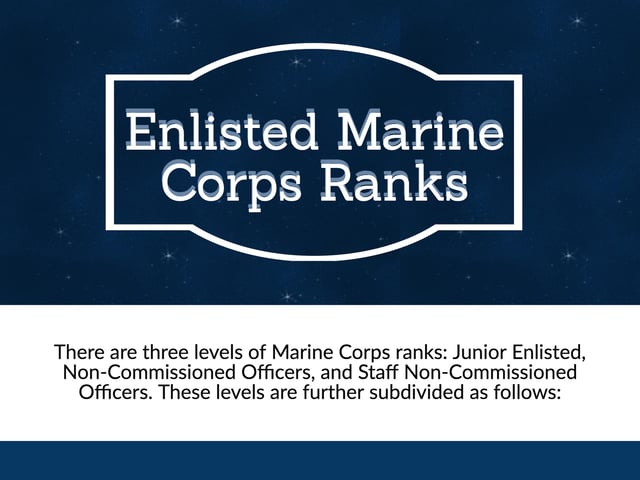
Marine Corps Rank
There are three levels of Marine Corps ranks: Junior Enlisted, Non-Commissioned Officers, and Staff Non-Commissioned Officers. These levels are further subdivided as follows:
Junior Enlisted
Private (E-1)
After graduating basic training, new recruits are awarded the title of Private. Most hold this ranking for 6 months before being promoted to Private 1st class, and promotion is typically automatic.
Private 1st Class (E-2)
A Private 1st Class can be promoted to Lance Corporal when they have been serving as a Marine for at least 9 months and have been a Private First Class at least 8 months.
Lance Corporal (E-3)
Lance Corporal is the highest Junior Enlisted rank. In order to become an NCO (E-4 or E-5), Lance Corporals are promoted based on a “composite score” system that seeks to find the most qualified candidates. Candidates are scored based on such factors as duty performance, conduct performance, physical fitness, and rifle marksmanship.
Non-Commissioned Officers
Corporal (E-4)
The rank of Corporal is a leadership position within the Marines. Corporals, like Sergeants, are expected to train, supervise, and discipline their subordinates, as well as maintain property and equipment. To get promoted to Sergeant, an E-4 must have been a Marine for at least 2 years and a Corporal for a year.
Sergeant (E-5)
The duties of a Sergeant are the same as Corporal, but a Sergeant is typically responsible for larger numbers of Marines, equipment, and property. To get promoted to a Staff NCO, a Sergeant must be vetted by a centralized NCO staff selection board and have served four years as a Marine, at least two of which are at the Sergeant level. Candidates must also complete the Professional Military Education course (PME).
Staff Non-Commissioned Officers
Staff Sergeant (E-6)
Staff Sergeants are typically in charge of platoons of 30 or more Marines. They assist with training and administrative duties and serve as the top tactical advisor to the platoon commander in times of war.
Gunnery Sergeant (E-7)
The rank of Gunnery Sergeant is unique to the Marine Corps. In this role, a Marine is expected to coordinate the weapons and logistics for a company of at least 180 Marines. In 2016, the starting pay for a Gunnery Sergeant was around $2600 a month.
First Sergeant (E-8)
A First Sergeant is the senior enlisted advisor to the commander of a unit, such as a company or platoon. They serve as the “middle man” and advocate between Marines and the commander. Those in this role must display a great deal of integrity, leadership, and professionalism. In 2016, a First Sergeant with eight years of service could expect to make around $3800 a month.
Master Sergeant (E-8)
Master Sergeants are high-ranking Marines who are experts in an assigned MOS, such as logistics or fire control. As such, they are expected to assist the commander in tactical and administrative duties related to their specialty. Like First Sergeants, in 2016 a beginning Master Sergeant could expect to make about $3800 a month.
Master Gunnery Sergeant (E-9)
A Master Gunnery Sergeant is the highest technical ranking in the Marines. They are experts in an MOS like aviation or artillery, and serve in a leadership role in larger units, such as companies or battalions. The starting salary of a Master Gunnery Sergeant is currently a little over $4600 a month.
Sergeant Major (E-9)
Sergeant Major is the highest rank available to non-commissioned officers following a general command path. They are the senior enlisted advisor for large Marine Corps units such as companies or battalions, and typically earn a starting salary of around $4600 a month.
Sergeant Major of the Marine Corps (E-9)
The Sergeant Major of the Marine Corps is selected by the Commandant of the Marine Corps and typically serves four years. In this role, a Marine is the Commandant’s right hand man when it comes to enlisted affairs.

Keep Reading

Armed Services Vocational Aptitude Battery Blog
What is the ASVAB Test?
The Armed Services Vocational Aptitude Battery, known as the ASVAB, is …

Armed Services Vocational Aptitude Battery Blog
Military MOS Codes
Military Occupational Specialty (MOS) codes are an integral part of the…

Armed Services Vocational Aptitude Battery Blog
U.S. Army Height and Weight Standards for Females
The U.S. Army’s commitment to maintaining a robust, physically fit, and…